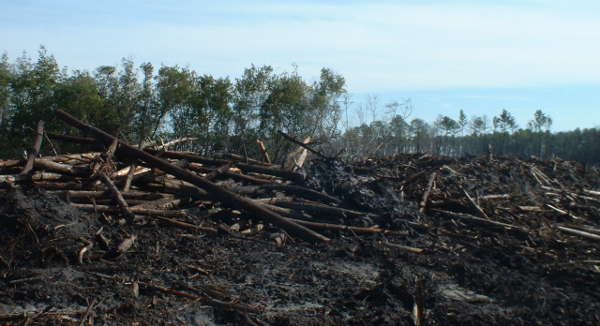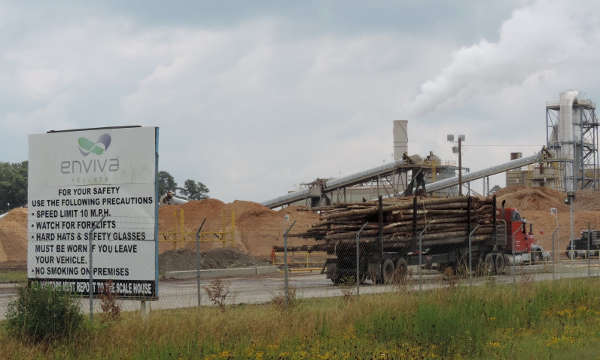Almuth Ernsting is co-director of Biofuelwatch, an NGO that works “to raise awareness of the negative impacts of industrial biofuels and bioenergy on biodiversity, human rights, food sovereignty and climate change”. She contributed this guest post to FSC-Watch.
How FSC is helping to greenwash the destruction of US forests for European power stations
By Almuth Ernsting, Biofuelwatch, August 2014
Burning wood in power stations is fast emerging as a major threat to forests. Across the EU, the renewable energy target of 20% by 2020 is to be met primarily through bioenergy, mainly through burning wood. In the UK alone, energy companies have announced biomass power station plans which, if implemented, would require around 66 million tonnes of wood a year being burnt – yet the UK only produces 10 million tonnes of wood annually.
Amongst the leaders in this emergent market are the largest European energy companies, including RWE, E.On and Vattenfall – the EU’s three biggest CO2 emitters from fossil fuel burning – as well as GDF Suez, Drax and Dong Energy.
From coal to wood pellets
In the UK, Drax Plc – owner of the country’s biggest coal power stations – is in the process of converting half of its capacity to burning wood pellets. For this, it will need to burn pellets made from almost 15 million tonnes of green wood every year – that’s 1.5 times the UK’s entire annual wood production. Already, Drax burns more wood than anyone else in the UK. The vast majority of its pellets come from British Columbia and the southern US, two regions where clearcutting of highly biodiverse forests is rampant. Like others in the biomass industry, Drax likes to speak about using sawmill and forest residues. Yet not only is the amount of genuine residues tiny compared to Europe’s growing biomass demand, but, for technical reasons, Drax relies on burning pellets from slow-growing whole trees with little bark. Residues are too high in bark and would damage their boilers.
Other energy companies, too, are converting coal power stations partly or fully to biomass, in order to avoid having to close them down under EU regulations and to cash in on generous government subsidies. For example, E.On converted the UK’s Ironbridge power station to biomass in early 2013. It is not clear how much wood E.On has actually burned there and Ironbridge is expected to close down next year. However, E.On is now planning to convert a defunct coal power station in the south of France to burning wood, against widespread protests from residents’ initiatives, environmental groups and local authorities. At the same time, companies are building large new power stations which will entirely run on wood, again, in order to profit from renewable energy subsidies.
Burning biodiversity
The EU produces 50% of all wood pellets worldwide, but burns 70%, so imports are increasing fast. By far the largest share of all EU wood pellet imports come from the (southern) US and Canada, followed by imports from Russia, Ukraine and Belarus (excluding trade within the EU, where the Baltic States are a major exporter to other countries). In the southern US, NGOs have shown that the biggest US pellet producer, Enviva, is sourcing a high proportion of wood from the clearcutting of bottomland hardwood forests – some of the most biodiverse temperate forests and freshwater ecosystems worldwide. Enviva supplies Drax and E.On amongst others.

Clearcutting of coastal native hardwood forests in North Carolina – Drax is burning pellets from native forest logging in this region. Photo: Dogwood Alliance.
Meanwhile, ever more scientists are warning that burning wood for energy is commonly worse for the climate than generating the same amount of energy from coal per unit of energy for a period of several decades or more.
Although various policy and industry analysts have predicted that the EU will in future rely on significant wood imports for bioenergy from the South America and Africa, too, this has not so far been borne out by actual investments. Instead, the impacts EU biomass policies on countries in the global South have so far been mainly indirect impacts. For example, new tree plantations in countries such as Ghana are being justified by the growing EU bioenergy demand even though nobody is investing in the infrastructure that would be needed to produce and export any pellets. Even if the EU might not end up buying much wood for power stations and boilers from countries in the global South, the impacts on the vast new demand on land-grabbing might still end up being very significant. After all, the EU has not so far imported much feedstock for liquid biofuels from Africa, yet ActionAid has shown that European investors had acquired 6 million hectares of land in Africa supposedly for biofuel production by May 2013.
FSC’s role: Greening the image of big biomass
So where does the FSC come into all of this? Clearly, the biomass industry has a problem with its image. BBC, Daily Mail Wall Street Journal and other articles which implicate UK biomass – and Drax in particular – in the clearcutting of US wetland forests have undermined ‘green’ claims. A recent UK government report confirming that electricity from biomass can be worse for the climate than that from coal hasn’t helped the industry’s image (even if the UK government has made it clear they won’t act on it) – nor has a letter by 41 US scientists to the EU that warned of the threat posed to southern US forests and the climate by European biomass policies. And to make matters worse for companies, a growing number of citizens groups are forming to stop individual biomass power stations.
Unsurprisingly energy companies and pellet producers as well as their supporters in governments are looking towards voluntary certification schemes for greening the image of big biomass. And they are doing so in two different ways: Through mandatory biomass sustainability standards, and through company policies.
The UK Government is not only the biggest importer of wood pellets worldwide, it also intends to become the first national government to introduce mandatory biomass greenhouse gas and sustainability standards, from April 2015 (albeit delayed from October 2013). The proposed standards have been widely criticised by UK NGOs, not least because they ignore the bulk of carbon emissions associated with bioenergy. According to the draft sustainability standards, wood will either need to be certified by the FSC or by a PEFC scheme, or companies can pay a consultant to confirm that it would meet those schemes’ requirements, even if the wood has not actually been certified. Controlled wood certification can account for up to 30%. While some NGOs continue to insist that the FSC is superior to other forest certification schemes and the only one that should be recognised, the FSC itself does not seem to object to all of the main certification schemes being treated as effectively equivalent in EU policy and legislation In fact, FSC is promoting greater recognition of ‘voluntary certification’ in general by the EU.
However, actual FSC forest management certification may not play a huge role in EU pellet imports in the near future, at least not as far as imports from the US are concerned. The southern US, which is the biggest pellet exporter worldwide, has relatively little FSC certification. This is due to the fact that 87% of forests and plantations in the region are privately owned, with family ownership accounting for 57% of the area and with 3 million owners each holding 9 acres or less. And small owners are much less likely to be able to or choose to pay for the additional expense of certification. Energy companies importing southern US pellets will therefore have to largely resort to paying for their own reports to say their wood would meets certification standards even if it’s not certified.
Controlled wood greenwash
For company greenwashing purposes, on the other hand, the FSC Controlled Wood Procedure comes in particularly handy. Pellet producers/exporters now routinely get accredited under that, which allows them to publicly declare that their pellets are ‘FSC certified’. In the UK, many pellet producers try to attract customers with FSC certification. One company for example claims on its website:
“LandEnergy’s long standing commitment to responsible forestry has now been confirmed with the award of Forest Stewardship Council (FSC) certification.
100% of our wood fibre is sourced from within the already well regulated UK market but this shows that our wood fibre is sourced from well managed forests with a focus on minimising any environmental impact.
The FSC process ensures that harvesting, timber transport, tracking and re-planting are all properly carried out and that our customers can buy with confidence from us.“
In fact, all that LandEnergy has got is a Controlled Wood assessment that says that absolutely any wood from the UK is ‘low risk’! LandEnergy may be a fairly small purely domestic pellet producer in the UK, but large and controversial pellet companies such as Enviva resort to the same tactic.
Remarkable claims from Bureau Veritas
Enviva had no problem getting all of their pellet mills certified under the Controlled Wood procedure – despite the all of the evidence linking them to clearcutting of highly biodiverse swamp forests. According to Bureau Veritas, the certifiers, there is little risk of forest management activities in the region threatening high conservation value areas, a strong system of forest protection exists across the US, nor is there much of a risk of natural forests being converted to plantations in the area.
Bureau Veritas’s claims are remarkable. First, there are virtually no restrictions on logging on privately owned land (i.e. in almost 90% of forests), including in wetland forests, in the southern US. Only small fragments of the original bottomland hardwood forests remain across the southern US and their high biodiversity as well as their ongoing destruction are very well documented. Second, Bureau Veritas justifies its claim that there is little risk of forests being converted to tree plantations by citing figures according to which wood production rates and tree cover in the area and/or across North America are stable. Those figures of course include plantations. By relying on them, Bureau Veritas (and through them the FSC) simply proves that it pays no attention at all to the criterion against forest conversion to plantations.
The US government’s Forest Service, on the other hand, admits in its report “Southern Forest for the Future” that:
“Forest landowners have shown a strong propensity to convert naturally regenerated forests to planted pines after harvesting, especially in the Coastal Plain, an investment response that is strongly linked to the condition of forest product markets.”
Coastal Plain forests are the ones targeted by Enviva. The report further warns that:
“Under strong demand forecasts, planted pine could expand by as much as 28 million acres — from 39 million acres in 2010 to about 67 million acres in 2060, or from 19 to 34 percent of the region’s forests (ch. 5) — most of which would come from conversions of natural pine forests after harvesting.”
Thus, while pellet producers and energy companies are creating a vast new demand for wood – and thus a major new driver for forest destruction – FSC is being used to help them to gain political legitimacy and, by implication, ongoing subsidies. Enviva’s Controlled Wood Certificate – granted in blatant disregard of the already extremely weak Controlled Wood standards – illustrates that the FSC is actively complicit in those efforts.


An FSC certified company just clear cut a county park containing 500 year old trees.
http://www.nrtoday.com/news/18830079-113/timber-sale-at-busenbark-county-park-generates-controversy